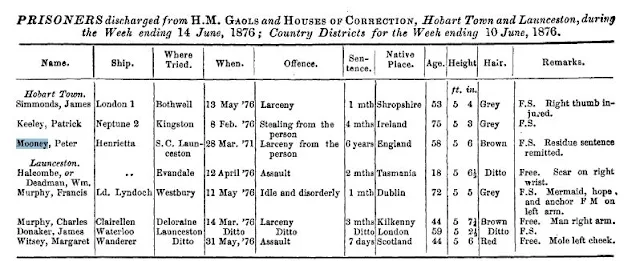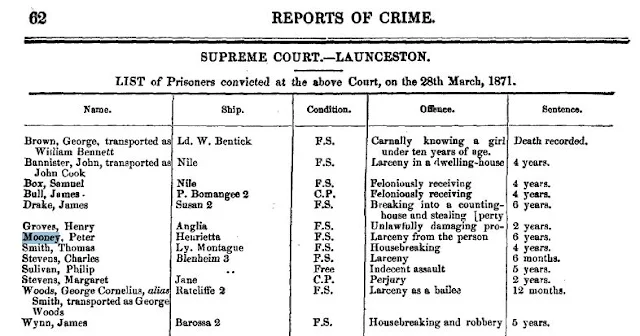Commercial photographer T.J. Nevin took these photographs as mugshots of men, recidivists who had offended locally and repeatedly, for the Municipal Police and Gaol authorities in Hobart between 1872 and 1880. By 1900, the 1870s mugshots had been removed from the original registers by the government photographer and commercial entrepreneur of convictaria, John Watt Beattie. The photographs initially had been arranged by the prisoner's discharge date, a common administrative practice which survived into the 1930s. However, the 1870s discharge registers have not survived intact. Late registers do survive, in which the prisoner's mugshot is accompanied by his criminal record and discharge notice. These are now held at the Tasmanian Archives and Heritage Office (Ref: POL708).

It is a singularly easy task to collate the names of the men in these 1870s mugshots held in public institutions (viz. the National Library of Australia, the Queen Victoria Museum and Art Gallery, the Tasmanian Museum and Art Gallery, the State Library of Tasmania, and the Mitchell Library NSW,) with the discharge dates of each prisoner.
The discharge notices of each prisoner whose mugshot survives are discoverable from the surviving police gazettes, in Nevin's time called Tasmania Reports of Crime Information for Police, James Barnard, Gov't Printer. All men were photographed who had Supreme Court convictions and lengthy sentences (search this site for extended articles on many of these prisoners, and the uses and misuses of their prisoner mugshots over the last 30 years).
Most men were photographed by Thomas J. Nevin in late 1874 at the Hobart Gaol, while he was still operating from his own studio, and then in 1875, the year he took a residency and full time position at the Hobart Town Hall as hall keeper and records keeper (including photographic records) for the Mayor's Court where prisoner discharges were rubber stamped for the Municpal Police Office also housed in the Town Hall. Cells located in the basement of the Hobart Town Hall were the transit stop for prisoners being relocated from regional lock-ups. They were either discharged by the Mayor's Court or taken to the Hobart Gaol (Campbell St Gaol) for further incarceration.
In short, the only way to contextualise these prisoners and their photographs is to start from the most recent police records rather than the usual procedure, the earliest - eg. starting from the late 1880s when many of the men in these mugshots were still active career criminals - and work back in time. Working back to the years 1880-1876, when Nevin's later prisoner photographs were taken also brings into the picture the assistance of his brother, Constable Jack Nevin at the Hobart Gaol. And then to 1876-1872, the years when the bulk of the ID photos were taken which Nevin furnished on commission for the Attorney-General W.R. Giblin in the mid 1870s, to the earliest known to survive dating from 1872. Finally, the "Port Arthur" discourse kicks in, as the journey finishes rather than starts at the point where these men first stepped onto Tasmania soil prior to July 1853 and only court room sketches were taken as to their "likeness". The reason for this reversal? We are talking about PHOTOGRAPHS, not "PORT ARTHUR", so it is the photographer's journey which mirrors and accompanies the criminal's mugshot. And Nevin was rewarded sufficiently with his commission, to avoid bankruptcy as many in his cohort had to face, and to provide for a large family in comfort.
Example:
PETER MOONEY (latest records 1884 to earliest records 1843)
Peter Mooney was a thief for thirty or more years, ending life as a pauper.
He was photographed by T.J. Nevin at the Hobart Town Hall Mayor's Court in the week ending 14th June 1876, after serving a lengthy sentence for larceny from a person, the same crime which brought him to Australia.
1884 Discharged

Peter Mooney was discharged (as pauper) on 4 June 1884.
1883 Discharged

Peter Mooney was sentenced for 3 months for larceny and discharged on 23 May 1883.
1879 Discharged

Peter Mooney was charged with being idle and disorderly and discharged on 9 August, 1879: forwarded to Hobart Gaol.
1876 Discharged

Peter Mooney was sentenced in March 1871 for larceny from a person, sentenced to 6 yrs, aged 58, discharged on 14 June 1876: FS Residue of sentence remitted..

Verso of carte-de-visite taken by T.J. Nevin of prisoner Peter Mooney (PAHS 2004:0003)
Peter Mooney was photographed on discharge by T.J. Nevin at the Hobart Town Hall Mayor's Court in the week ending 14th June 1876.

John Watt Beattie's advertisement for his commercial Port Arthur Museum ca, 1900 located at 51 Murray St Hobart. Source: QVMAG 1986_P_1223
The verso states "Taken at Port Arthur 1874", an inscription used by Beattie ca. 1900 while preparing many of these mugshots for display and to promote sales of authentic convictaria memorabilia in his "Port Arthur Museum" at the height of the 1890s tourist boom. Mugshots still attached to the original criminal records do not bear this inscription, nor do the earliest archival examples which escaped Beattie's reach.

Carte-de-visite taken by T.J. Nevin of prisoner Peter Mooney (PAHS 2004:0003)
1871 Convicted

Peter Mooney was convicted and sentenced to 6 yrs on 21 March 1871.
1870 Discharged

Peter Mooney was sentenced on 7 July 1864 to 7 years for horse stealing, discharged from Port Arthur 16 July 1870.
1843 Transported

Physical description of Peter Mooney 1843
CON18-1-38_00089_L

CON33-1-46_00118_L
Peter Mooney was transported to Van Dieman's Land (Tasmania) in 1843 for a 10 year sentence, his crime was theft of a hankerchief. Click on image for large view.
Convict indents and ship records held at the Tasmania Archives and Heritage Office.
